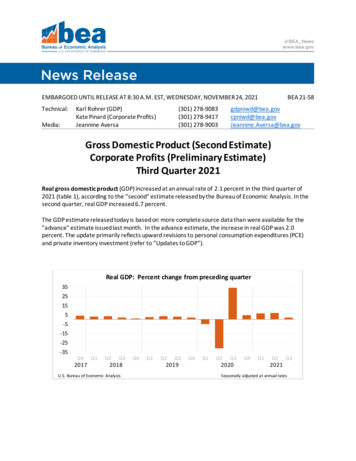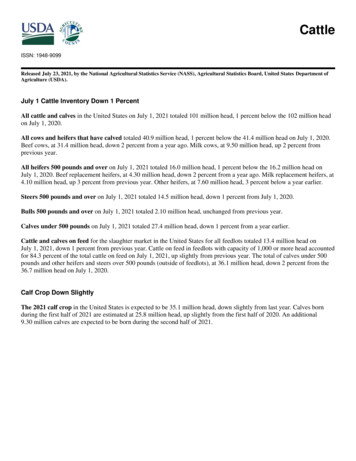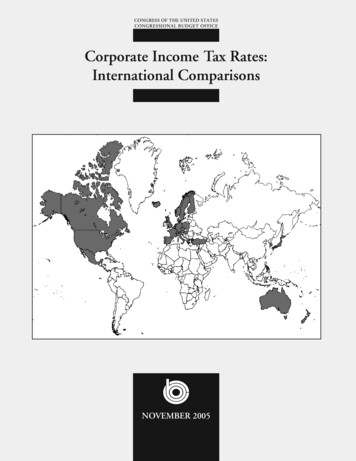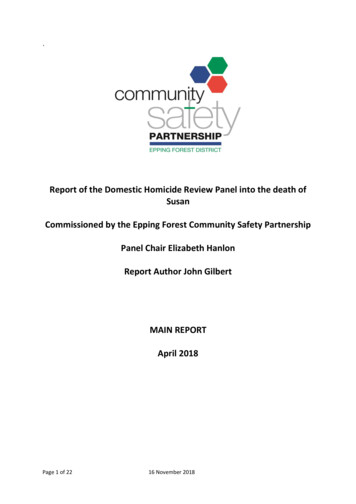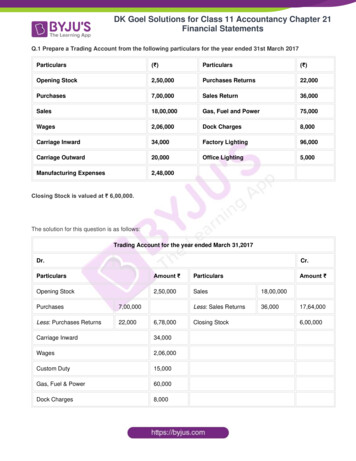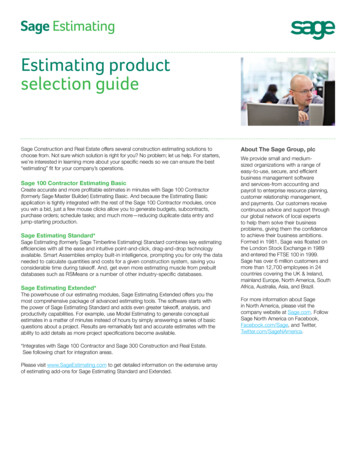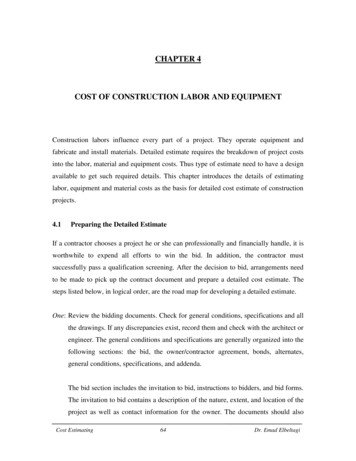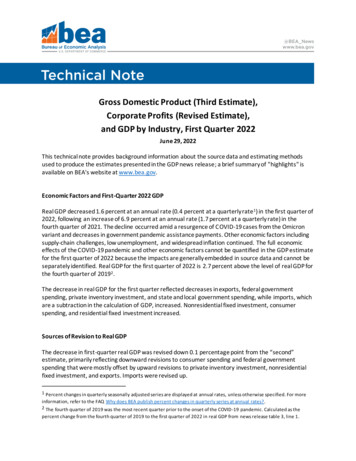
Transcription
Gross Domestic Product (Third Estimate),Corporate Profits (Revised Estimate),and GDP by Industry, First Quarter 2022June 29, 2022This technical note provides background information about the source data and estimating methodsused to produce the estimates presented in the GDP news release; a brief summary of "highlights" isavailable on BEA's website at www.bea.gov.Economic Factors and First-Quarter 2022 GDPReal GDP decreased 1.6 percent at an annual rate (0.4 percent at a quarterly rate 1 ) in the first quarter of2022, following an increase of 6.9 percent at an annual rate (1.7 percent at a quarterly rate) in thefourth quarter of 2021. The decline occurred amid a resurgence of COVID-19 cases from the Omicronvariant and decreases in government pandemic assistance payments. Other economic factors includingsupply-chain challenges, low unemployment, and widespread inflation continued. The full economiceffects of the COVID-19 pandemic and other economic factors cannot be quantified in the GDP estimatefor the first quarter of 2022 because the impacts are generally embedded in source data and cannot beseparately identified. Real GDP for the first quarter of 2022 is 2.7 percent above the level of real GDP forthe fourth quarter of 20192 .The decrease in real GDP for the first quarter reflected decreases in exports, federal governmentspending, private inventory investment, and state and local government spending, while imports, whichare a subtraction in the calculation of GDP, increased. Nonresidential fixed investment, consumerspending, and residential fixed investment increased.Sources of Revision to Real GDPThe decrease in first-quarter real GDP was revised down 0.1 percentage point from the “second”estimate, primarily reflecting downward revisions to consumer spending and federal governmentspending that were mostly offset by upward revisions to private inventory investment, nonresidentialfixed investment, and exports. Imports were revised up.1 Percent changes in quarterly seasonally adjusted series are displayed at annual rates, unless otherwise specified. For moreinformation, refer to the FAQ Why does BEA publish percent changes in quarterly series at annual rates?.2 The fourth quarter of 2019 was the most recent quarter prior to the onset of the COVID -19 pandemic. Calculated as thepercent change from the fourth quarter of 2019 to the first quarter of 2022 in real GDP from news release table 3, line 1.
Within consumer spending, both services and goods were revised down.o For services, revisions primarily reflected updated first-quarter Census QuarterlyServices Survey (QSS) data. Downward revisions to financial services and insurance(notably, banking and other financial services) and health care (notably hospitals) werethe leading contributors.o For goods, a downward revision to durable goods (led by recreational goods andvehicles) was partly offset by an upward revision to nondurable goods (more thanaccounted for by gasoline and other energy goods) based primarily on revised CensusMonthly Retail Trade Survey data and new March Petroleum Supply Report data fromthe Energy Information Administration, respectively. The downward revision to federal government spending primarily reflected a downwardrevision to national defense equipment investment, based on updated information from BEA’sInternational Transactions Accounts (ITAs) on federal transfers of military equipment. The revision to private inventory investment reflected an upward revision to nonfarminventories, led by retail trade (notably, general merchandise stores) and "other" industries(specifically, information), based primarily on revised Census Bureau inventory data. Within nonresidential fixed investment the upward revision was led by structures (mainlycommercial and health care), based primarily on revised February and March Census Value ofConstruction Put in Place data. The upward revisions to both exports and imports were based primarily on revised CensusBureau goods data as well as the annual revision of BEA's ITAs, which was incorporated on abest-change basis. Within exports, the leading contributor to the upward revision was goods(led by nonautomotive capital goods). Within imports, an upward revision to services (led bytransport) was partly offset by a downward revision to goods (led by nonfood andnonautomotive consumer goods).Real final sales to private domestic purchasers, which measures private demand in the domesticeconomy and is derived as the sum of consumer spending and private fixed investment, increased 3.0percent in the first quarter, a downward revision of 0.9 percentage point, reflecting the downwardrevision to consumer spending.PricesBEA's featured measure of inflation in the U.S. economy, the price index for gross domestic purchases,increased 8.0 percent in the first quarter, unrevised from the second estimate. Excluding food andenergy, gross domestic purchases prices increased 6.9 percent, also unrevised from the secondestimate.-2-
The price index for personal consumption expenditures (PCE) increased 7.1 percent in the first quarter,an upward revision of 0.1 percentage point from the second estimate. Excluding food and energy, the“core” PCE price index increased 5.2 percent, also an upward revision of 0.1 percentage point, primarilyreflecting updated BLS price indexes for medical insurance carriers. For a comparison of PCE prices toBLS consumer price indexes, refer to NIPA Table 9.1U. Reconciliation of Percent Change in the CPI withPercent Change in the PCE Price Index.Gross Domestic Income and Corporate ProfitsReal gross domestic income (GDI), which measures output of the economy as the costs incurred and theincomes earned in the production of goods and services (as measured by GDP), increased 1.8 percent atan annual rate (0.4 percent at a quarterly rate) in the first quarter, a downward revision of 0.3percentage point from the previous estimate. The updated estimate primarily reflected a downwardrevision to net interest, based primarily on new first-quarter assets data from the Federal ReserveBoard’s U.S. Financial Accounts as well as revised data from BEA’s ITAs. The average of real GDP and realGDI increased 0.1 percent at an annual rate (less than 0.1 percent at a quarterly rate) in the first quarter,a downward revision of 0.2 percentage point.Profits from current production decreased 63.8 billion, or 2.2 percent (quarterly rate), in the firstquarter. Domestic profits of financial corporations decreased 51.1 billion, domestic profits ofnonfinancial corporations decreased 4.8 billion, and rest-of-the-world profits decreased 7.9 billion. First-quarter profits were revised up 2.6 billion from the previous estimate, reflecting upwardrevisions to domestic nonfinancial industries profits, based primarily on updated CensusQuarterly Financial Report data, and to rest-of-the-world profits, based on updated ITA data.The upward revisions were partly offset by downward revisions to domestic financial industriesprofits, based on updated tabulations of publicly traded companies’ earnings.BEA’s profits measure that is conceptually most similar to S&P 500 profits —national after-tax profitswithout inventory valuation and capital consumption adjustments—increased 26.4 billion in the firstquarter. First-quarter national after-tax profits (shown in line 11 of table 9 of the GDP news release)increased 15.2 percent from the same quarter one year ago.Real GDP by IndustryToday’s release includes estimates of GDP by industry, or value added—a measure of an industry’scontribution to GDP (shown in table 12 of the news release). In the first quarter, private goodsproducing industries decreased 6.9 percent, private services-producing industries decreased 0.8percent, and government increased 2.0 percent. Overall, 9 of 22 industry groups contributed to the firstquarter decline in real GDP. Within private goods-producing industries, the leading contributors to the decrease werenondurable goods manufacturing (led by petroleum and coal products) and mining.-3-
Within private services-producing industries, decreases in retail trade as well as finance andinsurance were partly offset by an increase in real estate and rental and leasing. The increase in government reflected an increase in state and local government that was partlyoffset by a decrease in federal government.Updates to Disposable Personal IncomeCurrent-dollar disposable personal income (DPI) was revised down 51.3 billion in the first quarter to alevel of 18.20 trillion, primarily reflecting an upward revision to personal current taxes, which are asubtraction in the calculation of DPI. Personal current taxes were revised up 50.3 billion, reflecting anupward revision to federal taxes, specifically, declarations and settlements, based on new data from theDepartment of the Treasury that showed a stronger than expected filing season for settlementscompared to 2021. Partly offsetting the upward revision was a downward revision to state and localpersonal current taxes, based on new data from the Census Bureau’s Quarterly Tax Survey. For detailedestimates on personal current taxes, refer to NIPA table 3.4U.Federal Government Economic Response to the COVID-19 PandemicSince the onset of the COVID-19 pandemic, several legislative acts, including the Coronavirus Aid, Relief,and Economic Security (CARES) Act; the Coronavirus Response and Relief Supplemental Appropriations(CRRSA) Act; and the American Rescue Plan (ARP) Act, were signed into law. The Acts established severaltemporary programs and provided additional funding for existing federal programs to supportindividuals, communities, and businesses impacted by the pandemic. Because the effects of the Actswere in the form of transfers to individuals, subsidies to businesses, and grants to state and localgovernments, their effects on GDP show up indirectly through the components of GDP, such asconsumer spending, business investment, and government spending. Thus, BEA cannot separatelyidentify the total effect of the Acts on changes in GDP.It is possible, however, to identify the impacts of select recovery programs on aggregate federalgovernment spending. Further information on these and other pandemic response programs, includingestimates of the effects of these programs on federal government spending is available in Effects ofSelected Federal Pandemic Response Programs on Federal Government Receipts, Expenditures, andSaving.Looking Ahead: 2022 Annual Update of the National Economic AccountsBEA will release results from the 2022 annual update of the National Economic Accounts, which includesthe National Income and Product Accounts as well as the Industry Economic Accounts, on September 29,2022. The update will present revised statistics for GDP, GDP by Industry, and gross domestic incomethat cover the first quarter of 2017 through the first quarter of 2022. For details, refer to Information onUpdates to the National Economic Accounts.-4-
More InformationThe complete set of statistics for the first quarter is available on BEA's website, along with a tablepresenting the "Key Source Data and Assumptions" that underlie the statistics. In a few weeks, theSurvey of Current Business, BEA’s online monthly journal, will present a more detailed analysis of theestimates ("GDP and the Economy").Erich H. StrassnerAssociate Director, National Economic AccountsBureau of Economic Analysis(301) 278-9612-5-
supply-chain challenges, low unemployment, and widespread inflation continued. The full economic effects of the COVID-19 pandemic and other economic factors cannot be quantified in the GDP estimate for the first quarter of 2022 because the impacts are generally embedded in source data and cannot be separately identified.
